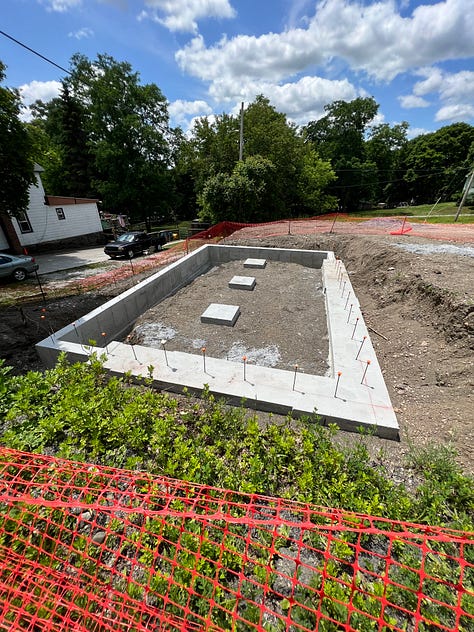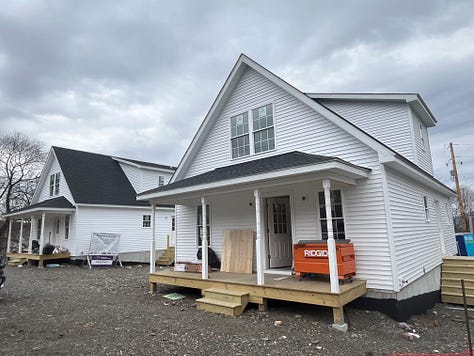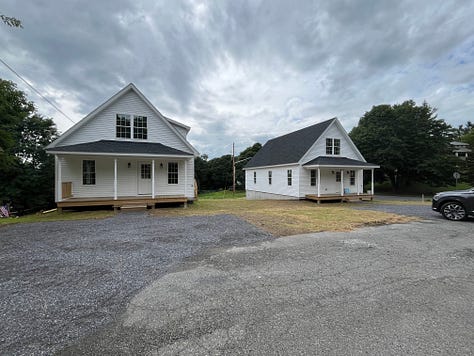Two families became Columbia-Greene Habitat for Humanity homeowners this week. What does it take to get a family into a new Habitat home? It is a long process, both for the families and for us.
This was the culmination of several years of work by the many hands, hearts and heads that make up the community that supports our program. We cannot accomplish what we do without active community participation at all levels. We find helpful heroes in every town, village and hamlet: in the residents, elected officials, faith groups, organizations and businesses.
Below is a peek at what was involved in this last effort and a timeline of the development cycle. Some of the details have been edited for the sake of brevity and clarity.
We started planning for this project as far back as 2018, when the parcel of land became available. Then a cascade of stuff happened: COVID, building cost spikes, a change of leadership, staff changes, and an inflow of new residents into our area that spiked rents and housing prices and created an unprecedented housing crisis that we are still in the throes of.
This altered reality necessitated a rethinking of our original building plan. Rather than the duplex townhouse that was initially approved in 2020, we decided to build twin 3 bedroom cape-style houses on adjoining parcels. In the aggregate, it was a simpler and less costly effort, and the homes fit better into the neighborhood.
We broke ground in May 2023, a full three years after we bought the property from the village that owned it. It had been the site of the former municipal garage and was a vacant lot for many years. Local residents had come to use the empty space for many purposes and some were vocally unhappy to lose this “privilege.“
Before we could begin building, we needed to conduct a full environmental assessment of the lot. It passed, and construction in earnest started in July 2023. The homes received their certificates of occupancy in June 2024. Ninety individuals and six organizations contributed more than 500 volunteer hours to the year-long effort, plus we received thousands of dollars in donated or discounted materials, products and services.






We opened applications for these houses in October 2023 and began interviewing applicants a couple of months later. The criteria for being accepted into the Habitat home ownership program is pretty short:
A demonstrated need for housing
Ability to qualify for an affordable mortgage (usually through one of our lending partnerships)
The willingness to partner with Habitat in the construction of their home (or other Habitat programs)
The process, while straightforward, is a new experience for most of our applicants. Our potential partners mostly do not have home ownership in their personal experience, nor the financial or home management experience that other would-be homebuyers often do. Together with our partners, Habitat provides the education and support structures that our first-time homeowners need to be successful.
In our 30-year history, spanning the construction and sale of 28 homes (one twice!), our partner families have a 100% success rate in maintaining ownership. The Habitat program works, especially for those who have been traditionally shut out of home ownership opportunities.
Financing our building projects is less straightforward than the application or construction processes. Our homes are affordable because we provide a subsidy between what it costs us to build and what a partner family can afford. We do not give houses away, contrary to the opinion of many.
Our “sales price” — the actual price an individual pays for their house — is pegged at 30% of the household income level. We have had to raise the income levels that we can consider for our program due to ever-escalating costs, including local taxes. Where we once could serve those below 50% of Area Median Income, that is no longer so. Our income criteria is now 50-75%. That change notwithstanding, our homes are still affordable to those who make an average wage in our service area.
We must find funding to fill the gap between what the potential buyer can afford to pay and what it costs us to develop the home. This funding gap has become harder and harder to secure and the gap is growing each year. Over the past decade, construction costs have soared, average wage incomes have stagnated, and housing grants and loan programs have constantly changed (or been cut back) at the local, state and national level.
This limits our ability to scale development, as each project has a different financial profile, and each must be forecast and funded separately. But we persist.
We are changing our destiny through our Rural Starter Home Initiative. The goal of this program is to increase our production of housing by creating an affordable, replicable and scalable development template. And eventually, to offer plans and product to other affordable housing organizations.
* * *
Some believe that government wades into areas better served by other means. While it may be true that it’s hard to find the right balance between social investments and financial stewardship, even when there is agreement on policy goals, that does not support eliminating social programs. It is incontrovertible that investments placed into Habitat housing projects provide a clear return to the individuals and communities involved.
New ideas, emerging initiatives, the impact of investments in affordable housing, and how each of us can be a housing hero in our communities, will be subjects of future posts.
Stay tuned.
“Far better it is to dare mighty things, to win glorious triumphs, even though checkered by failure, than to take rank with those poor spirits who neither enjoy much nor suffer much, because they live in the gray twilight that knows not victory or defeat.” - Theodore Roosevelt






Thank you for providing a concise and detailed look at the process, and its changes and challenges.
Private organizations, such as religious groups and service-oriented associations, once were an integral part of the social safety net of many communities. I've seen claims that government welfare programs et al. pushed them out, but surely that's just part of the full picture. Increased costs, regulations, liability, and a decline in civic awareness and volunteering all play a role; and I'm sure I'm missing some thing.
I don't mean to sound like an old crone ... yet there is truth in the observation that many of mainstream American culture's problems would be meaningfully addressed if more people simply started caring more about their local community and its inhabitants, and acted accordingly.
What ever happened to the home "kits" of the 1950s?